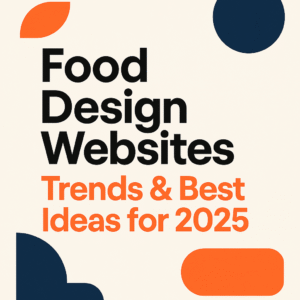Food Design Websites Trends: Best Ideas for 2025

We know that crafting a remarkable website is key to succeeding in the food industry. Whether you’re a restaurateur, food blogger, or own a food truck or delivery service, your website’s design and pricing play an important role as your digital storefront. Exploring food website examples, or leveraging the best website builder for restaurants or food trucks, can significantly impact how effectively you attract and retain customers in the crowded marketplace.
Emerging Trends in 2025
In 2025, several innovative trends promise to elevate your food website’s aesthetic appeal and user experience (UX). From stunning visual elements to smart marketing strategies that foster customer loyalty, our guide to the 20 food design websites trends will show you how to stay ahead and thrive in a competitive industry landscape.
Building an Engaging and Functional Website
Whether you’re exploring inspiration from the best food design websites, searching for the ideal website builder for restaurants, or aiming to create a standout takeaway website design, adopting these trends will help reinforce your brand’s online presence. We’ll equip you with insights into modern food web design templates and best practices to craft a site that drives both engagement and sales.
Visual and Aesthetic Trends

Dark Mode Designs
One of the most prevalent visual trends in 2025 is the incorporation of dark mode designs. This trend is not just about aesthetics; it also offers practical benefits. Dark mode reduces eye strain, especially in low-light conditions, and can even help in reducing energy consumption on devices.
For food websites, dark backgrounds paired with vibrant food imagery create a dramatic and upscale look, making the dishes stand out while providing a sophisticated user experience. Websites like Reddit and Mozilla have already implemented this feature, allowing users to toggle between light and dark themes based on their preferences.
Advanced Animations
Advanced animations are another key visual trend that is enhancing the user experience on food websites. Storytelling through microinteractions, such as subtle animations and playful hover effects, adds a layer of delight and engagement.
For example, a steaming coffee cup icon or a hover effect on a cookbook link can reinforce the brand identity and make the website more interactive and enjoyable. These microinteractions help create a more human and approachable feel, making the website feel more alive and engaging to users.
3D Elements and AR Experiences
The use of 3D elements and augmented reality (AR) experiences is revolutionizing the way food websites present their offerings. Interactive 3D models allow diners to virtually rotate a dessert or preview portion sizes, bringing the food to life on the screen. AR previews enable users to see how dishes would look in real life, enhancing the decision-making process and providing a more immersive experience.
This trend is particularly effective for food delivery services and restaurants looking to showcase their menu items in a more engaging and interactive way.
User Experience (UX) Enhancements

AI-Powered Personalization
In 2025, AI-powered personalization is revolutionizing how food design websites deliver user experiences. This cutting-edge technology enables websites to offer hyper-personalized journeys, tailoring content, recommendations, and even menu suggestions based on individual visitor preferences and behaviors.
For example, AI can analyze past orders and browsing histories to suggest dishes or promotions that resonate with specific users. This level of precision has been shown to substantially increase engagement, with reports indicating that AI-driven personalization can boost user interaction rates by up to 80% and significantly enhance overall customer satisfaction.
Accessibility and Inclusivity
Accessibility and inclusivity are becoming essential pillars of UX design for food websites. Ensuring that websites are usable by all visitors, including individuals with disabilities, is not only a legal compliance measure but also a commitment to equal access for all.
Key features include high-contrast modes, screen reader compatibility, and intuitive navigation structures. Many sites are also adopting inclusive language and imagery that reflect the diversity of their audience. By prioritizing accessibility, food businesses can expand their reach while building a more welcoming brand identity.
Voice Navigation
Voice navigation is emerging as a pivotal UX enhancement in 2025. With widespread adoption of voice assistants like Siri, Alexa, and Google Assistant, users are becoming increasingly adept at interacting with digital platforms using voice commands. Food websites are leveraging this trend by integrating voice navigation capabilities that allow users to search recipes, place orders, or locate nearby restaurants hands-free.
This innovation enhances usability for individuals who prefer seamless interactions or have mobility challenges. Moreover, it aligns with the growing movement towards creating more intuitive and accessible digital experiences.
Marketing and Engagement Strategies

Integrated Social Media
Integrated social media strategies are essential for engaging customers and driving traffic to your food website. In 2025, restaurants are leveraging platforms like Instagram, TikTok, and Facebook to showcase their dishes, promote events, and interact with customers in real-time. Creating high-quality visuals, engaging captions, and interactive formats such as polls or stories can significantly boost engagement. To learn more about leveraging these strategies effectively, read more about the latest marketing trends and tools.
Short-form videos highlighting menu items, kitchen processes, or chef interviews are particularly effective in capturing user attention. Collaborating with local influencers or food bloggers can also amplify your reach. These partnerships allow you to tap into the influencer’s audience, who often trust the opinions of these local tastemakers.
Regularly posting content, running interactive campaigns, and responding to customer feedback are essential for building a strong online presence that drives foot traffic and online orders.
Local SEO Optimization
Local SEO optimization is vital for ensuring that your food website appears prominently in local search results. This involves optimizing your website with relevant keywords, creating content that is geographically targeted, and ensuring your business is listed in local directories.
Geo-targeted ads and content can push potential customers to your physical location or online ordering system. For example, using keywords related to your location and menu items can help local customers find your restaurant when searching for dining options in their area.
Additionally, encouraging customers to leave reviews on platforms like Google My Business can improve your local search rankings and build trust with potential customers. Local SEO strategies help in creating a strong online presence that attracts local customers and drives both online and offline sales.
Subscription-Based Models
Subscription-based models are becoming increasingly popular in the food industry as a way to foster customer loyalty and generate recurring revenue. These models can include monthly meal kits, subscription boxes featuring artisanal foods, or loyalty programs that offer exclusive discounts and perks. By offering a consistent and convenient experience, you can encourage customers to return regularly, thereby increasing customer retention and overall revenue.
For instance, a restaurant could offer a monthly subscription for exclusive access to new menu items, special events, or priority reservations. This not only provides a steady stream of income but also helps in building a loyal customer base that feels valued and connected to the brand.
Conclusion
In 2025, the landscape of food website design is evolving to meet the sophisticated expectations of modern consumers. To stay ahead, it’s vital to incorporate visual and aesthetic trends such as dark mode designs, advanced animations, and 3D elements. Enhancing user experience through AI-powered personalization, accessibility, and voice navigation is also essential.
Marketing strategies should include integrated social media, local SEO optimization, and subscription-based models to engage and retain customers. Remember, high-quality ingredients, plant-based options, and sustainable practices are driving consumer choices. By embracing these trends and focusing on user experience, personalization, and innovative marketing, you can create a compelling online presence that attracts and retains customers, ultimately driving the success of your food business.
FAQ
What is a food designer called?
A food designer is commonly referred to as a “food stylist.” These professionals specialize in designing, preparing, and styling food to achieve visually stunning results for photography shoots or on-air demonstrations, capturing culinary artistry at its finest.
How much does a food website cost?
The cost of building food design websites differs greatly, ranging from $500 to $10,000 or more. The price depends on factors like complexity, features such as product catalogs, service descriptions, and whether advanced components like contact forms or e-commerce integrations are included.
What is a food website?
A food web represents a complex system of connected food chains within an ecosystem. It maps out the multiple pathways through which energy and nutrients are transferred across organisms, illustrating the deeper feeding relationships and ecological interactions among various species.
How to design a restaurant website?
Designing a restaurant website involves delivering a responsive and accessible experience across all devices. Begin with high-quality photos that tempt the viewer, then pair them with clear and concise menus to streamline browsing. Thoughtfully intuitive navigation paired with prominent call-to-action buttons, such as “Reserve Now,” creates seamless interactions. For inquiries or tailored web solutions, don’t hesitate to contact with us for expert guidance on crafting your perfect digital storefront.
Additionally, prioritize essentials like contact details, social media integrations, and fast page-loading speed. A clean layout, minimalistic typography, and easy menu scrolling will ensure your audience enjoys a hassle-free experience while engaging with your restaurant online.
What services do you offer for food design websites?
We specialize in creating customized websites for the food and restaurant industry. Our services include:
- Eye-catching design tailored to your brand.
- Mobile-friendly layouts for seamless user experience.
- Online ordering, reservation systems, and event booking features.
- High-quality food photography integration.
- SEO optimization to drive traffic to your site.
- Ongoing support and updates.
What makes a great food design websites?
A great food design website combines visually appealing design, intuitive navigation, and practical features like online ordering or reservation systems. It should reflect your brand’s unique personality while providing a seamless experience for your customers.
Why choose us for your food design websites?
We specialize in creating stunning, functional food design websites tailored to your business needs. From mouthwatering food photography to mobile-friendly layouts, we ensure your site is a true reflection of your culinary brand.
How can I get started?
For Making Food design websites? Click the button below to learn more about our services and see how we can bring your food design websites to life!
See Our Services
See Our Pricing
Contact With Us
Take your online presence to the next level with a food design websites that stands out and delivers results!
